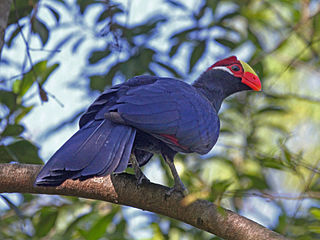
The violet turaco, also known as the violaceous plantain eater, is a large turaco, a group of African otidimorphae.

Eupithecia is a large genus of moths of the family Geometridae. There are hundreds of described species, found in all parts of the world, and new species are discovered on a regular basis.

The lime-speck pug is a moth of the family Geometridae. It is a common species throughout the Palearctic region, the Near East and North Africa.

The common pug(Eupithecia vulgata) is a moth of the family Geometridae. It is a common species across the Palearctic region, the Near East and North Africa. It ranges from the Atlantic coast of Ireland and Portugal across Europe, the Middle East and Central Asia to the Russian Far East (Priamurje) and Korea.

The juniper pug or juniper looper is a moth of the family Geometridae. The species was first described by Michael Denis and Ignaz Schiffermüller in 1775. It is found throughout the Palearctic and Nearctic regions and the Near East.

Lysergol is an alkaloid of the ergoline family that occurs as a minor constituent in some species of fungi, and in the morning glory family of plants (Convolvulaceae), including the hallucinogenic seeds of Rivea corymbosa (ololiuhqui), Argyreia nervosa and Ipomoea violacea. Lysergol is not a controlled substance in the USA. Its possession and sale is also legal under the U.S. Federal Analog Act because it does not have a known pharmacological action or a precursor relationship to LSD, which is a controlled substance. However, lysergol is an intermediate in the manufacture of some ergoloid medicines.
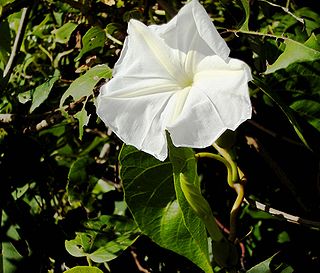
Ipomoea violacea is a perennial species of Ipomoea that occurs throughout the world with the exception of the European continent. It is most commonly called beach moonflower or sea moonflower as the flowers open at night.

Banksia violacea, commonly known as violet banksia, is a species of shrub or tree in the plant genus Banksia. It generally grows as a small shrub to 1.5 m (5 ft) high with fine narrow leaves, and is best known for its unusually coloured dark purple-violet inflorescences. The colour of the inflorescences, short leaves, and flattened follicles which are sticky when young, help identify this species from others in the field. It is found in low shrubland in southern regions of Western Australia from Esperance in the east to Narrogin in the west, growing exclusively in sandy soils.

Hardenbergia violacea syn. H. monophylla is a species of flowering plant in the pea family Fabaceae, native to Australia from Queensland to Tasmania. It is known in Australia by the common names false sarsaparilla, purple coral pea, happy wanderer, native lilac and waraburra. Elsewhere it is also called vine lilac or lilac vine.

Eupithecia innotata, the angle-barred pug, is a moth of the family Geometridae. The species was first described by Johann Siegfried Hufnagel in 1767. It ranges from Spain in the west to western Siberia and Central Asia in the east.
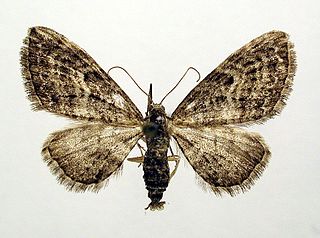
The larch pug is a moth of the family Geometridae. The species can be found in Europe, the Ural Mountains, West and Central Siberia, the Altai Mountains, Transbaikalia, Yakutia, the Far East, Mongolia, Korea, Japan and in North America, from Yukon and Newfoundland to New York and Arizona.

Eupithecia simpliciata, the plain pug, is a moth of the family Geometridae. It is found in the Palearctic ecozone, from western Europe to north-western China (Xinjiang).

Eupithecia venosata, the netted pug, is a moth of the family Geometridae. It was first described by Johan Christian Fabricius in 1787. It is found across the Palearctic ecozone from Portugal and Morocco in the west to the Lake Baikal in Siberia and Afghanistan and Pakistan in the east.

Oenopota is a genus of sea snails, marine gastropod mollusks in the family Mangeliidae.
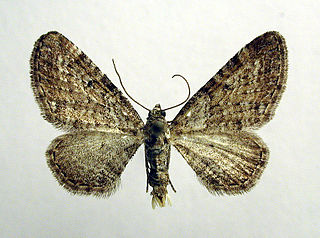
Eupithecia pernotata, or Guenée's pug, is a moth of the family Geometridae. The species was first described by Achille Guenée in 1857. It is known from the Alps, through Romania to southern Russia. It is also found in Finland.
Nymphaea violacea, also known as blue lily, is a waterlily in the genus Nymphaea.
Eupithecia variostrigata is a moth in the family Geometridae. It is widespread in the western Palaearctic, ranging from Spain to the western Pamirs in the east.
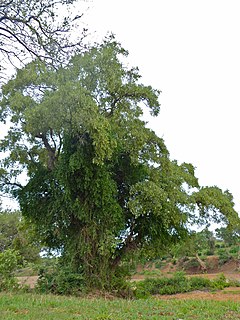
Philenoptera violacea know also as apple leaf or rain tree, Afrikaans: Appelblaar, Sotho: Mphata, Tsonga: Mohata, Zulu: Isihomohomo) is a plant species in the legume family (Fabaceae).
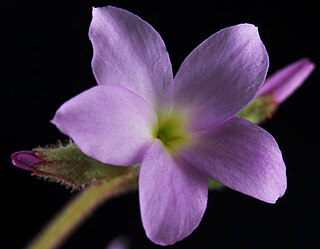
Suksdorfia violacea is an uncommon species of herbaceous flowering plant in the saxifrage family known by the common name violet suksdorfia. In 1879 Asa Gray named the genus Suksdorfia after Wilhelm Nikolaus Suksdorf who had first collected a specimen of S. violacea in 1878 near Mount Adams-White Salmon, Washington and sent it to Gray for assistance in classifying it. Gray and Suksdorf had a long and close working relationship, and Gray initially identified and named various species found by Suksdorf. Its conservation status has been rated by NatureServe as "G4 – Apparently Secure".
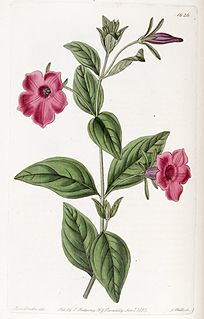
Petunia integrifolia and Petunia violacea have both been known by the vernacular name of violet petunia or violetflower petunia, both being species of wild petunia with violet-colored blooms. Petunia integrifolia is native to Argentina. P. integrifolia bears flowers approximately 1.5 inch in diameter and the plant is typically smaller and harder to cultivate than the well-known hybrid bedding Petunia now known correctly as Petunia × atkinsiana.
















